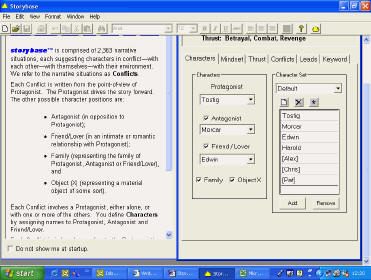Storybase
- Storybasesearch for term
Ashley Wilde Inc
$99 for download version www.storybase.net/software/software.html
I recently presented a paper at an archaeological conference where the subsequent debate centred around the definition of some words we thought we all understood. The distinction between information and interpretation became vital. And where exactly does data turn into evidence?
Understanding terms is essential if you want to take full advantage of Storybase. What you might loosely term ‘plot’, is broken down into conflicts and leads. Each Conflict is written from the point of view of the Protagonist. It is the Protagonist who drives the story forward, but you can change the character list to create several storylines. So, once you have extracted the Leads, you can juggle the names to view things from the viewpoint of the other characters.
The other characters are Antagonist, Friend/Lover, Family and what is called Object X. You need to give the individuals names to keep track of them. So a little bit of pre-planning is required. The nature of the relationship between the Protagonist and the others can be created by defining their Mindset. You have 26 mindsets to choose from and you are limited to 3 choices. The final output works best when the choices have been sensible and consistent.
How the Mindsets interact, depends on which of the 34 Thrusts you select. The Thrust defines the situation or context, such as death or seduction. The output is called a Conflict. These are a set of sentences generated by Storybase. These can be copied and pasted into your developing story.
Finally there are Leads. These are really plotlines. They are broken into Leadins, that come before a Conflict and Leadouts suggesting what comes next with a linkline in the middle. You can click through these separately or let the software link the ‘ins’ and ‘outs’ for you.
So much for the functions, but what does this achieve? Storybase is not a ‘one-click’ solution. You need to play around with the various suggestions, explore your characters and think about the output. When you see something that appeals to you in the conflicts or leads, you can copy and paste it into your word processor.
The value of this software depends on how much you need to generate the emotional framework for the characters in your story. If you are writing short stories or have to provide regular scripts for a series, Storybase could provide invaluable inspiration. You will need to shuffle the names around to see how your cast of characters interact. If you are prepared to spend an hour doing this, you can come away with many potential paths for your story to follow.
Storybase helps you define the essence of your story. It was easy to install and getting started takes just a few minutes. Like all tools, you need to spend a few hours to get to know it. Try to generate a few story outlines to understand how you can explore its potential. If you are a well-organised writer who produces detailed sketches, you can survive without this software. If you are in a hurry, and want some novel angles, Storybase might help.
Storybase suggests that non-fiction would benefit from the same approach to hold the attention of the audience. Unlike some other packages, Storybase does not generate pages of text. Instead it provides you with leads that you, as the story-teller, can expand. Storybase might be overpriced for the limited task that it undertakes, but it is a useful tool for those skilful enough to exploit it.

© Chas Jones 2004
